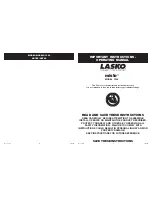
10
11
7. OUTSIDE WEATHERHOODS AND DUCTING TO THE
OUTSIDE.
The outside weather hoods must have built in bird screens to prevent birds and rodents from
entering the duct system. Minimum mesh size of 1/4” must be used. Smaller mesh size will
result in restricted air flows with increased potential for the development of blockages.
Vent hoods with gravity dampers must not be used.
Weather hoods should be installed:
a) A minimum of 6 ft. apart from each other.
b) At least 18” above ground level
c) Away from sources of contaminates such as automobile exhaust
fumes, gas meters, garbage cans.
d) Locate away from prevailing winds whenever possible.
The size and design of the weather hoods shall be selected to ensure adequate free area to
minimize air flow restrictions.
It is recommended that 6” insulated ducting with a integral single piece vapour barrier be
provided. Due to the high air flow restrictions in insulated flex duct it is recommended that run
lengths be kept to a minimum, stretched tightly and with as few elbows as possible, if length
greater 25 ft. use 7” insulated duct. Minimum RSI value of 0.75 (R4) is required.
Weather hood collar should be screwed to inner surface of sill plate and sealed with high quality
caulking or aluminum faced tape. Both the inner and outer liners of flexible ducting should be
securely attached to the weather hood tubing and collar and to the HRV collar. A good bead of
high quality caulking (preferably acoustical sealant) should be used prior to clamping the liners.
It is very important to ensure that the fresh air intake line is well sealed and that the vapour
barrier is sealed.
Содержание Proventor II Series
Страница 2: ...2 ...












































